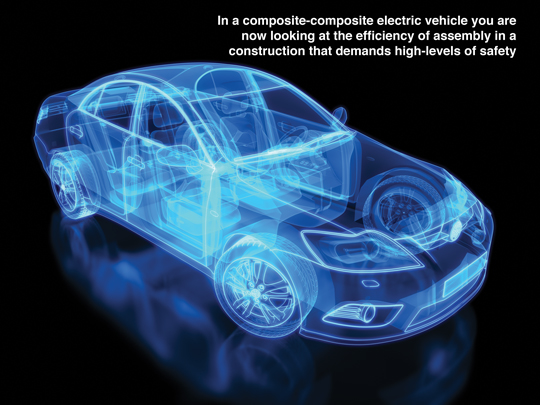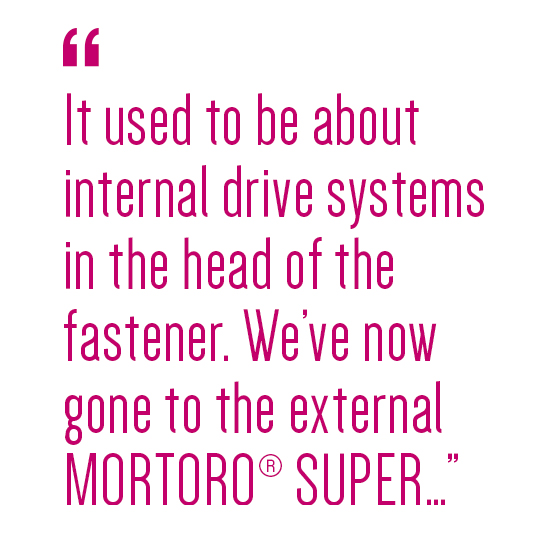
PART THREE
Powertrains are changing and a lot faster than was previously anticipated. What does that imply?
“That’s an area where we’ve been at the forefront with some of the automotive manufacturers. We bring experience from some of the cutting-edge aerospace industry we’re dealing with. Look for example at fibre composite, solar powered drones where weight is the ultimate consideration. Now look at an electric vehicle where weight is a much more critical issue because every kilo that can be saved is X amount of kilowatts of battery longevity. That becomes a much more interesting fastening equation. The more you can do with composite-composite joints, as opposed to metal-metal-composite joints the better. Those are areas we are looking at very closely.
The evolution of fastener drive systems is something that is never really going to stop because you always face another problem to resolve. Maybe you need ultimate torque capability in a tamper resistance design because the vehicle is going into a high theft region - or an electric braking system you don’t want accessed because of liability issues.
In a composite-composite electric vehicle you are now looking at the efficiency of assembly in a construction that demands high-levels of safety. Heavy batteries must be secured not just against the extraordinary forces of collision but also the repetitive g-forces of braking and high speed cornering. So you need a fastener assembly that will survive the stresses exerted by those heavy loads over a long period and you needed threaded fasteners – because you need service access.
It’s a very different set of parameters from a combustion engine vehicle but nevertheless the ultimate joint characteristics are not dissimilar from what you see with a head bolt. You see more sheer stress with battery compartments than tensile stress but you still need the same clamp load to keep it all together.”

Where next for Phillips and for mechanical fasteners generally?
“We’ve started to go outside our historic comfort zone. It used to be about internal drive systems in the head of the fastener. We’ve now gone to the external MORTORQ® SUPER which was a significant departure for us.
We’re developing a recess in the thread end of the fastener. There is a big demand for that in aerospace. It can’t be so large that you deform the thread or you burst the thread when tightening the fastener. Those types of application are more aligned with composite-composite where you have a flush surface on the outside of the bolt.
We’re seeing similar requirements in the large head type of fastener designed to be embedded into composite material, which is being used more in automotive but also in boats and other applications. People are realising that when the nut is run onto the stud it imparts torque loads which start twisting the head inside the composite – fracturing fibres and creating weakness. A recess in the thread end prevents rotation within the bonded structure, eliminating a potential failure path. That’s already proven to very effective in a number of areas.
We definitely see a trend more to bonded fasteners. When you look at what is being done panel-to-panel, non-rigid to rigid, you are going to see a lot more of these joints – for example a flexible plastic joined to a CFRP panel. We’re certainly seeing some interesting things in the aerospace world, which are out and beyond the bounds of what you usually see.
The greater the vehicle longevity the more the balance between insertion and removal of a fastener becomes an issue. Our assertion has always been you need to have better removal than insertion capability – the exact ratio is debatable but you always want your removal torque requirement to be a little bit better than what it took to install it. When the fastener is inserted it is generally in a clean, controlled and well-equipped environment. It’s a different story one year, five years, twelve years down the road when its gone through some nasty stuff. An aircraft experiencing temperatures from –40ºC to +40ºC, even a cooker cycling regular from hot to cold, let alone a car that’s gone through sand, salt, snow and car wash.
When you take the joint apart it normally requires 25% to 50% more torque than it took to install it. That’s why we have a design philosophy that says better in removal than installation.
Eventually you’ve got to recycle it these days, and design for recyclability is driving a lot of what is going on in the automotive world now. That has an impact on the complete life-cycle carbon footprint – just by reducing the energy required for disassembly by having fasteners that will allow the separation of different materials.”

What inhibits the development?
“The interesting thing is what the barriers to rapid adoption of innovation are. A lot of industries are held back by a combination of ‘Not invented here’ with ‘Gee, I just don’t know’. You run into a lot of companies that fall into the NIH camp, but you also run into a lot that simply have not had the time to think about it.
They are so busy producing the product they don’t have time to look at how they should optimise the product so they are tied to technologies that might well stem from the 1950s. Is it safe? Absolutely. Have you proven it’s safe? Absolutely. Is it the best solution available to use? No it’s not. Can you be somewhere further down the line by a few changes? Yes you can – absolutely.
It’s not a lack of the technology – it is a lack of the daring to apply the latest technology – and also a lack of comprehension of the capability of that technology.
You run into two types of engineer in any industry, the glass half full and the glass half empty. Glass half full – it’s good enough, I’ve slaked my thirst. I have a proven system: I am not going to break what doesn’t need fixing. Glass half empty: with just a little more technology, a little more daring, I can take this to the top of the glass and have something exceptional.
The buzzword these days is disruptive technology. What needs to be recognised is the level of optimisation and incremental advances that are essential milestones on the road to a disruptive technology. Look at the Boeing 787. Yes, the carbon fibre fuselage is a disruptive technology but there were so many incremental technologies that helped Boeing to get there. Optimising the fastener for lightning strike because now, instead of conductive aluminium it is non-conductive carbon fibre. Optimising the floor fastening system because you’ve got a CFRP floor going into titanium stringers and it needs to all be a single sided assembly.
When you look at the end result it is actually the sum of a lot of incremental innovation. It is about having an organisation that will embrace the incremental innovations to reach the disruptive innovation.
It’s also about a company like ours that every so often succeeds in nudging the process forward. Here’s a small step, well that worked well, so here’s another, a little bit larger…”
Don't have an account? Sign Up
Signing up to FastFixTechnology.com enables you to manage your account details.